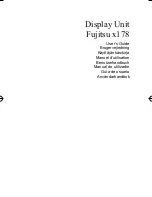
30
31
flaws in the bioelectrical system that regulates the heart-
beat. The symptoms (skipped or premature heart beats,
pulse being slow or too fast) can be caused by factors
such as heart disease, age, physical make-up, excess
stimulants, stress or lack of sleep. Arrhythmia can only
be determined through an examination by your doctor.
If the symbol
is shown on the display after the meas-
urement has been taken, repeat the measurement. Please
ensure that you rest for 5 minutes beforehand and do not
speak or move during the measurement. If the symbol
appears frequently, please consult your doctor. Self-
diagnosis and treatment based on the measurements can
be dangerous. Always follow your GP’s instructions.
Risk indicator:
The measurements can be classified and evaluated in ac-
cordance with the following table.
However, these standard values serve only as a general
guideline, as the individual blood pressure varies in di
ff
er-
ent people and di
ff
erent age groups etc.
It is important to consult your doctor regularly for advice.
Your doctor will tell you your individual values for normal
blood pressure as well as the value above which your
blood pressure is classified as dangerous.
The bar chart on the display and the scale on the unit
show which category the recorded blood pressure values
fall into. If the values of systole and diastole fall into two
di
ff
erent categories (e.g. systole in the ’High normal’ cat-
egory and diastole in the ’Normal’ category), the graphical
classification on the device always shows the higher cat-
egory; for the example given this would be ’High normal’.
Blood pres-
sure value
category
Systole
(in mmHg)
Diastole
(in mmHg)
Action
Setting 3:
severe
hypertension
≥
180
≥
110
seek medical
attention
Setting 2:
moderate
hypertension
160 – 179
100 – 109
seek medical
attention
Setting 1:
mild
hypertension
140 – 159
90 – 99
regular
monitoring by
doctor
High normal
130 – 139
85 – 89
regular
monitoring by
doctor
Normal
120 – 129
80 – 84
self-monito-
ring
Optimal
< 120
< 80
self-monito-
ring
Source: WHO, 1999 (World Health Organization)
Summary of Contents for BC 57
Page 112: ...112 2 1 5 LR03 Beurer 1 1 112 2 113 3 118 4 119 5 121 6 123 7 125 8 128 9 129 10 129 11 131...
Page 114: ...114 CE 93 42 EEC 5 5 30...
Page 115: ...115 30...
Page 116: ...116...
Page 117: ...117 WEEE Waste Electrical and Electronic Equipment...
Page 120: ...120 Bluetooth Bluetooth M 5 M M M M 12...
Page 122: ...122 5 5 EE_ M...
Page 123: ...123 M1 M2 Bluetooth Bluetooth 30 Bluetooth 30 Bluetooth 3 3 5 6 5...
Page 125: ...125 7 60 M Bluetooth M A M AM 7 5 00 9 00 M PM 7 18 00 20 00...
Page 126: ...126 M 03 M 5 M...
Page 131: ...131 RED 2014 53 EU www beurer com web we landingpages de cedeclarationofconformity php 11...
Page 151: ...151...
















































